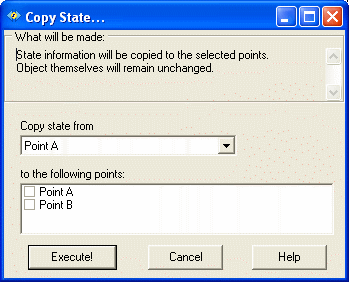
 |
 |
| |
|
|
ZSKSoft Synchronizer documentation |
Copy State
This command copies the state (list of objects and their properties) from one point to one or more other points. The program copies the current state of the source point and then copies it to both the current and the previous state of the target points, i.e. they appear as if they were unchanged.
This can be useful during "acquaintance" (first synchronization) with a slow point (scanning of which may take a lot of time), if you are sure that this point is already synchronized (see the example).
The command is available on the main menu (Commands/More/Copy state) or from the object's context menu. When you launch this command, the following dialog will appear:

On the drop-down list, select the source point. Then select the points, to which the data is to be copied. The program doesn't copy data to the original point even if it is selected.
When the command is selected, the program automatically sets the first not-slow point it meets as the source and selects all the slow points.
Example: Suppose, you have a web site on the Internet, and its local copy is stored on your computer. When you need to modify the web site or add new information to it, you edit the local copy, then check whether everything is correct, view it in different browsers, make necessary changes if something is not right, then check it again, and so on. Finally, when the local copy completely satisfies you, you move the changes to the web site.
Little by little, the web site is growing, gains popularity, the number of files and folders in it steadily increases, and it gets to where it's difficult to figure out what has changed during the latest update and what hasn't; copying the entire web site during every updates appears to be too long and literally unbearable. In such case, you get yourself ZSKSoft Synchronizer and create a project for synchronizing the web site with the local copy in it. Since ZSync tries to not scan the slow points where it's not really necessary, first of all it will suppose that the web site is new (blank) and will suggest you to copy the local to the Internet completely. Here you will tell it: just "Copy the state"! It will write information on the found files and folders from the local point to the web site point and will know from now on that the files are already synchronized. Again, this all will be carried out without a single connection to the web site; you will not even have to get online.
After that, when you edit the local copy next time, ZSync will automatically determine what has changed in it and, by your command, will move the changes to the web site. It will gladly take the routine part of the work on it, having left the creative part for you.